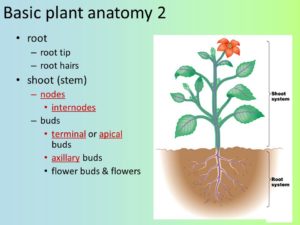What is the difference between stems and roots?
Everyone knows that stems and roots tend to be quite different. However, there are some cases whereby roots and stems have close similarities such that making a distinction can be a nightmare.
The biological discussion provides a detailed insight into the difference between stems and roots with a comparison table. The main aim is to enable the learner to differentiate instances where stems and roots look similar.

What Are Stems?
Stems are part of the plant body that appears above the soil surface. These parts tend to possess buds, leaves and stem hairs. They contain vascular tissues that transport water and minerals from the roots to other parts. Besides that, they are also responsible for the translocation of manufactured food through photosynthesis.
What Are Roots?
Roots are part of the plant body that remains inside the soil after the germination of the seed. The main function of the root is to offer support, absorption of water, storage of food reserves and absorption of mineral ions.
Comparison Chart: Stems Vs Roots
| Basic Terms | Stems | Roots |
| Meaning | Part of the plant that grows above the soil | Part of the plant that grows below the soil |
| Origin | Arise from the plumule part of the embryo. | Arise from the radicle part of the embryo. |
| Chlorophyll | Present | Absent |
| Phototropism | Grows upwards towards the light direction | Grows downwards away from light direction |
| Diameter | Larger | Smaller |
| Outgrowths | Leaves, nodes, and internodes | Root hairs at the tips |
| Buds | Present | Absent |
| Geotropism | Negatively geotropism | Positive geotropism |
| Stomata | Present on young stems | Absent |
| Nature | Either unicellular or multicellular | Unicellular |
Core Differences between Stems and Roots
- Stems develop from plumule while roots develop from radicle
- The stem is the part of the plant body above the soil while the root is the part of the plant body below the soil
- Stem experience positive phototropism while root experience positive geotropism
- Stems are either unicellular or multicellular while roots are unicellular
- Stems have chlorophyll while roots do not have chlorophyll
- Stems support the leaves and flowers while roots offer general support to the plant
- Stems are responsible for photosynthesis, storage and transportation while roots for anchorage and absorption of water
- Stems have vascular bundles that are collateral and conjoint while roots have vascular bundles that are radial
- Roots can be classified into taproot and fibrous root while stems into the soft stem and woody stem
- Young stems have stomata while roots have no stomata
- Roots have broad cortex while stems have a narrow cortex
- Pericycle of roots is single-layered while that of the stem is a multilayer
- Stems have both xylem and phloem fibers while roots do not have them
- Stems are differentiated into nodes and internodes while roots into nodes and internodes are absent
- Root cap is at the tip of the root while stem tip has a terminal bud
Comparison Video
Summary
The core difference between stems and roots is that stems are developed from plumule which implies that they appear above the soil while roots are developed from the radicle which implies that they appear below the soil.